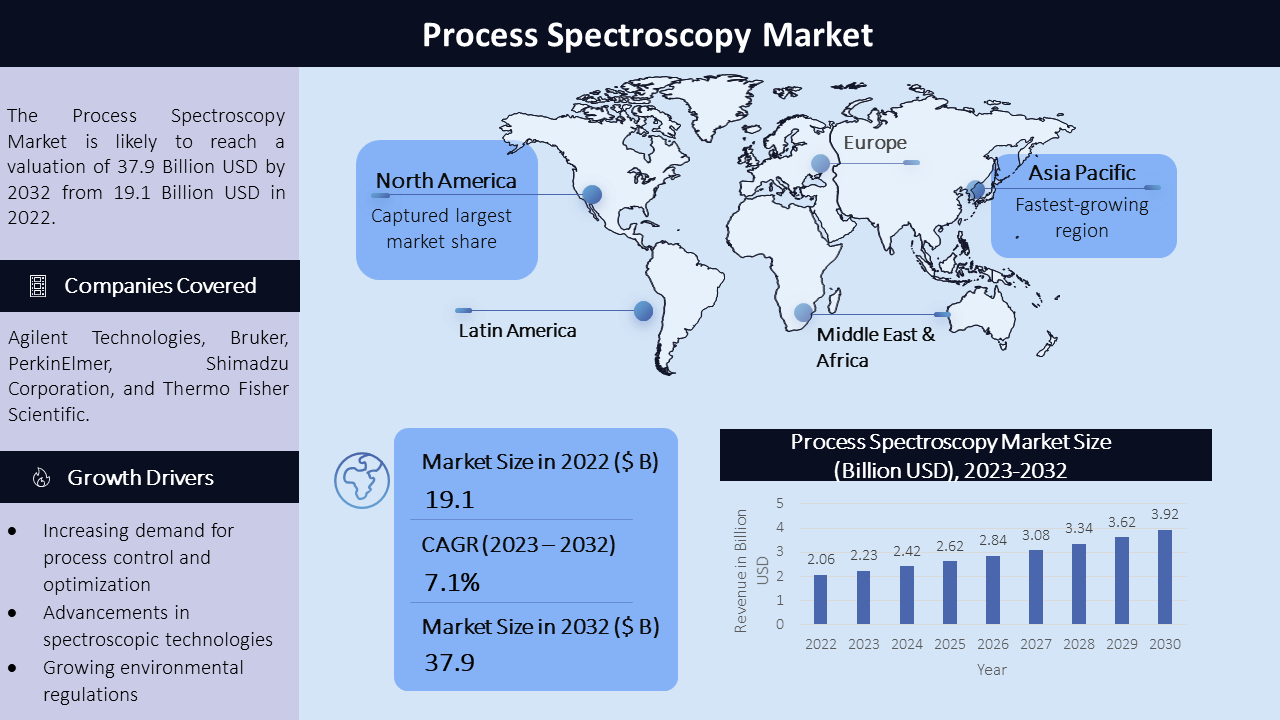Process Spectroscopy Market By Type (Infrared Spectroscopy, Ultraviolet-Visible Spectroscopy, Nuclear Magnetic Resonance Spectroscopy); By Application (Petrochemical, Pharmaceutical, Food And Beverage, Environmental Monitoring); By End-User (Industrial And Commercial Users, Research Institutions); ; By Region (North America, Europe, Asia Pacific, Latin America, Middle East & Africa) - Global Market Analysis, Trends, Opportunity and Forecast, 2022-2032
Process Spectroscopy Market Definition and Overview
Process spectroscopy refers to the use of spectroscopic techniques for monitoring and analyzing chemical and physical processes in industrial settings. These techniques are used to measure various parameters like temperature, pressure, and concentration, as well as to identify and quantify the presence of specific chemical compounds. Process spectroscopy is used in various industries, such as petrochemical, pharmaceutical, food and beverage, and environmental monitoring.
Process Spectroscopy Market Share and Size
The market size for process spectroscopy market was USD 19.1 billion in the year 2022. It is expected that the market size for process spectroscopy will increase by approximately USD 37.9 billion by 2032 as the market for process spectroscopy is continuously growing at a compound annual growth rate (CAGR) of 7.1% during the forecast period 2023-2032. The worldwide market for process spectroscopy is expected to grow significantly in the upcoming years. The market is driven by increasing demand for process control and optimization in various industries. Other factors contributing to market growth are advancements in spectroscopic technologies, increasing environmental regulations, and growing demand for process analytics in the pharmaceutical and biotech sectors.
The market for process spectroscopy is highly competitive, with various companies offering a range of spectroscopic instruments and systems. Key players in the market include Agilent Technologies, Bruker, PerkinElmer, Shimadzu Corporation, and Thermo Fisher Scientific.
Process Spectroscopy Market Report Scope |
|
|
Base Year Market Size |
2022 Usd 19.1 Billion
|
|
Forecast Year Market Size
|
2032 Usd 37.9 Billion |
|
Cagr Value
|
7.1% From 2023 To 2032 |
|
Segmentation
|
|
|
Challenges
|
|
|
Growth Drivers
|
|
Process Spectroscopy Market Key Drivers
There Are Various Factors Which Help In The Growth Of The Process Spectroscopy Market. They Are As Follows:
- Increasing Demand for Process Control and Optimization: For efficiency and yield of industrial processes, process spectroscopy is used in various industries like petrochemical, pharmaceutical, and others. This drives the market demand for the spectroscopy market.
- Advancements in Spectroscopic Technologies: The advancements in spectroscopy techniques enable more accurate and efficient measurements of process parameters and identification of chemical compounds. This leads to an increase in market demand.
- Growing Environmental Regulations: Process spectroscopy is used in environmental monitoring, for which the government is implementing various regulations, to measure the concentration of contaminants and other parameters. This drives the demand for spectroscopic instruments and systems.
- Growing Demand for Process Analytics in The Pharmaceutical and Biotech Sectors: The pharmaceutical and biotech industries are increasingly using process spectroscopy to optimize and control their manufacturing processes. This helps to improve the quality and consistency of the products they produce, which drives demand for spectroscopic instruments and systems.
Process Spectroscopy Market Challenges
There Are Many Challenges Which Are Faced By Process Spectroscopy Market. They Are Listed Below:
- High Cost of Instruments and Systems: The high cost of process spectroscopy instruments may act as a barrier for small and medium-sized industries (SMEs).
- Lack of Skilled Personnel: The spectroscopy instrument requires trained personnel for proper operation and maintenance. A lack of skilled personnel may act as a barrier for companies looking to adopt them.
- Limited Availability of Calibration Standards: Certain types of compounds or processes need suitable calibration standards which have limited availability and may act as a challenge.
- Interferences and Limitations of Certain Techniques: Some spectroscopic techniques may affect interferences from other compounds, which can limit their accuracy and sensitivity. Moreover, certain techniques may not be suitable for certain types of compounds or processes, which can limit their usefulness in certain applications.
Process Spectroscopy Market Regional Synopsis
- North America: The North American market is the largest. The market is driven by the presence of various pharmaceutical and biotech companies. It also has high adoption of advanced spectroscopic technologies in various industries.
- Europe: It is the second-largest market. There is a significant demand in the pharmaceutical and food and beverage industries.
- Asia Pacific: It is the fastest-growing market. It is driven by the increasing adoption of spectroscopic techniques in various industries. There is a growing demand for process control and optimization as well.
- Rest of the World: Latin America, the Middle East, and Africa are the regions included in the rest of the world. There is moderate growth in the region. The market is driven by increasing demand for process control and optimization in various industries.

Process Spectroscopy Market Segmentation
The Process Spectroscopy Market Is Segmented Into Various Categories Which Are Listed Below:
By Type
- Infrared Spectroscopy
- Ultraviolet-Visible Spectroscopy
- Nuclear Magnetic Resonance Spectroscopy
By Application
- Petrochemical
- Pharmaceutical
- Food And Beverage
- Environmental Monitoring
By End-User
- Industrial And Commercial Users
- Research Institutions
By Geography
- North America
- Europe
- Asia Pacific
- Rest Of The World
By Instrument Type:
- Handheld Spectroscopy Instruments
- Benchtop Spectroscopy Instruments
Process Spectroscopy Market Key Players:
- Agilent Technologies
- Bruker
- Perkinelmer
- Shimadzu Corporation
- Thermo Fisher Scientific
- Abb Group
- Buchi Labortechnik Ag.
- Foss
- Horiba
- Kaiser Optical Systems
- Others

Need Customized Report for Your Business ?
Utilize the Power of Customized Research Aligned with Your Business Goals
Request for Customized Report- Quick Contact -
- ISO Certified Logo -

















